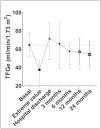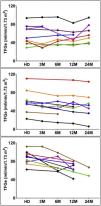Three years after the WHO announced the coronavirus disease pandemic 2019 (COVID-19), nearly 700 million infections and 7 million deaths have been confirmed worldwide.1 Many survivors have long-term cardiovascular, pulmonary, neurological and cognitive residual effects.2 Acute kidney injury (AKI) associated with COVID-19 has a complex pathophysiology, affecting renal function by different mechanisms (including direct viral tissue invasion), producing tubulointerstitial, glomerular and/or vascular damage.3,4 The incidence of AKI among patients hospitalized with COVID-19 is 17% (although in some series it was up to 80%).5 Recent studies warn that there are also long-term renal consequences affecting these patients.6,7 Lumlertgul et al.6 showed that 16.4% of patients who had presented AKI associated with COVID-19 had chronic kidney disease (CKD) after 3 months. Bowe et al.7 showed that hospitalized patients with AKI associated to COVID-19 have a difference in the decline of estimated glomerular filtration rate (eGFR) of −8.4 (95% CI = −9.7 to −7.1) ml/min/1.73 m2 for each year compared with non-infected controls.
Our group previously published the incidence, risk factors, and impact of AKI in patients hospitalized for COVID-19 between March and October 2020 in 2 hospitals of the city of Córdoba, Argentina.8 The aim of this new analysis was to evaluate the long-term eGFR evolution of subjects included in the previous study who had presented AKI associated with COVID-19.
A retrospective cohort study was performed. All patients from the previous study who had presented AKI associated with COVID-19 during hospitalization were included.8 Those who died during admission were excluded and patients were followed up for 2 years after hospital discharge. Serum creatinine levels were recorded and eGFR was calculated using the CKD-EPI 2009 equation9 at different times during follow-up. CKD was defined as a eGFR<60 ml/min/1.73 m2 and AKI according to KDIGO.10 For comparisons, Wilcoxon signed-rank test for dependent samples and MacNemar test were used. To calculate the annual decline in eGFR, only patients with serum creatinine at hospital discharge and at least one control during post-discharge follow-up were included, using the following formula = (last eGFR during post-discharge follow-up minus eGFR at hospital discharge) × 12 months/months of follow-up. The study was reviewed and approved by the research committee of the Private University Hospital of Córdoba, who decided that informed consent was not required because of the observational and retrospective design of the study, the anonymity of the data, and that it did not pose any risk to the participants.
Of the 448 patients included in the original study, 85 presented AKI and, of these, 45 survived to discharge (32 had presented AKI grade I, 10 grade II and 3 grade III). During post-discharge follow-up 12 patients had control of serum creatinine after 3 months, 19 after 6 months, 22 after 12 months and 16 after 24 months. The evolution of eGFR expressed as median (interquartile range) at the previous time (baseline), extreme values during AKI, at hospital discharge, after 3, 6, 12 and 24 months post-discharge were 64.5 (52.4–77.6), 37.5 (22.8–47.8), 71.9 (48.6–89.7), 65.6 (39.2–89.6), 57.8 (42.9–67.1), 57.2 (42.4–71.9) and 54.2 (41.3–68.9) ml/min/1.73 m2, respectively (Fig. 1); therefore, there was a recovery of baseline eGFR at discharge, but thereafter it was observed a progressive and statistically significant decrease after 6, 12 and 24 months of follow-up, compared to basal values (p < 0.05). Taking into account only the control period with the largest number of individuals (22 patients at 12 months) there was a clear trend towards an increase in patients with CKD from 40.9% (9/22) to 59.1% (13/22), (p = 0.125). Taking into account only the 27 patients who had serum creatinine measurements at hospital discharge and at least one during subsequent control (Fig. 2) the mean annual fall in eGFR was −8.2 ml/min/1.73 m2 (95% IC = −12.3 to −4.1).
Long-term evolution of the estimated glomerular filtration rate (eGFR) during follow-up in hospitalized patients who had presented acute kidney injury associated with COVID-19.
The values inside the vertical bars represent the median, and the ends of the bars the interquartile range. The horizontal dotted line represents the basal value.
*p < 0.05 compared to baseline.
Evolution of the estimated glomerular filtration rate (eGFR) of subjects who had serum creatinine measurement taken at hospital discharge and at least one control during post-discharge follow-up (n = 27).
HD: hospital discharge; M: months.
There are 3 figures with 9 patients in each for ease of visualization, ordered according to the magnitude of annual change in eGFR.
In this study, it was performed a long-term follow-up of eGFR of patients who had presented AKI associated with COVID-19. This did not include a follow-up control group, but it can be observed that the loss of eGFR over time is much greater than the average annual decline of eGFR in the general population. In addition, although the increase in the percentage of patients with CKD at 1 year is not statistically significant, it does appear to be clinically significant, and probably there is little statistical power in our sample to demonstrate these differences. Moreover, since the earliest stages of CKD (I and II) are not considered, the percentages are probably higher. Although this analysis has limitations (high loss to follow-up, small sample, limitations of serum creatinine as an estimator of GFR, and absence of data on proteinuria and hematuria), there are currently few studies that evaluate the long-term after-effects in renal function in patients with a history of AKI due to COVID-19. In conclusion, there was a significant worsening of eGFR at 6, 12, and 24 months after AKI associated with COVID-19 and an accelerated annual decline in eGFR in these patients. These data highlight the importance of including this group of patients in subsequent follow-up and warn of a possible increase in the occurrence of CKD due to the high global rate of infection.
FundingThe present investigation has not received specific support from public sector agencies, commercial sector or non-profit organizations.
Conflict of interestAll authors declare that there is no conflict of interest.
To the Nephrology Foundation of Córdoba.












